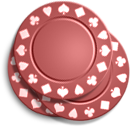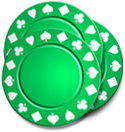



The outcome of poker games is determined by the hand held by each player at the showdown. Poker hands are ranked as follows, from the best possible hand to the worst possible hand:
The highest hand in Poker, a 'Royal Flush' consists of holding an A, K, Q, J and 10 of the same suit.
A 'Straight Flush' is the second highest Poker hand and requires you to hold five consecutively ranked cards of the same suit, such as A, 2, 3, 4 and 5 of hearts.
Four cards of equal rank from each of the different suits, for example: Ace of Hearts, Ace of Clubs, Ace of Diamonds and Ace of Spades.
A Poker 'Full House' hand is three cards of one rank and two cards of another rank. For example, A, A, A, K, K.
Five cards of the same suit but not in order (a Straight Flush). For example, 2, 3, 4, 6 and 9 of the same suit.

A 'Straight' hand involves five cards of consecutive rank (E.g. 4, 5, 6, 7, 8) but not of the same suit.
Moving towards the lower end of the poker hands, a 'Three of a Kind' is three cards of the same rank, such as A, A, A, 2, 4.
One of the more easy to understand hands is the 'Two Pair': Two cards of one rank and two cards of another rank. For example, A, A, 3, 3 and K.
Similar to the hand above, a 'One Pair' simply consists of you having a single pair of two cards of the same rank, such as A, A, 4, 8 and 9.
Where no other hand has been made, the hand is valued according to the highest card.
If there is ever a tie between two or more players (for example, because two players have a straight) then the winner will be the player with the highest card in that hand. 5, 6, 7, 8, 9 would therefore beat 4, 5, 6, 7, 8. Suits are irrelevant as far as values are concerned and are therefore not used to decide on tied pots.

